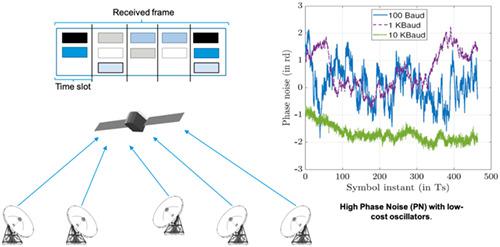当前位置:
X-MOL 学术
›
Int. J. Satell. Commun. Netw.
›
论文详情
Our official English website, www.x-mol.net, welcomes your
feedback! (Note: you will need to create a separate account there.)
Phase noise impact on the performance of contention resolution slotted random access schemes
International Journal of Satellite Communications and Networking ( IF 0.9 ) Pub Date : 2019-09-13 , DOI: 10.1002/sat.1325 Karine Zidane 1 , Riccardo De Gaudenzi 1 , Nader Alagha 1 , Stefano Cioni 1
International Journal of Satellite Communications and Networking ( IF 0.9 ) Pub Date : 2019-09-13 , DOI: 10.1002/sat.1325 Karine Zidane 1 , Riccardo De Gaudenzi 1 , Nader Alagha 1 , Stefano Cioni 1
Affiliation

|
Cost‐effective satellite terminals (STs) that are designed for a large scale deployment in the Internet of things (IoT) applications are constrained by consumer‐grade local oscillators (LOs) to lower the costs, on the one hand, and by limited equivalent isotropic radiated power (EIRP) due to limited peak transmit power and/or low antenna gain, on the other hand. To close the link budget with the low EIRP constraint, STs can resort to adopting robust forward error correcting (FEC) schemes and/or limiting the transmission baud rate, hence increasing the link margin with respect to the required receiver threshold. In general, the LOs at the terminal side are responsible for injecting multiplicative phase distortions to the transmitted signal, known as phase noise (PN). The PN caused by low‐cost LOs could be significant, especially for low baud rates, thus affecting the demodulator performance. Random access (RA) techniques are particularly encouraged on the return link in networks with low‐cost terminals and bursty/low‐duty cycle types of traffic. The state‐of‐the‐art time‐slotted RA techniques are often evaluated considering high EIRP at the terminal side and high baud rates. This paper investigates the impact of the PN in time‐slotted RA techniques and optimizes different carrier phase estimation (CPE) algorithms. Furthermore, it evaluates the impact of CPE errors on RA performance for a wide range of baud rates and typical STs phase noise masks.
中文翻译:

相位噪声对竞争解决方案时隙随机接入方案的性能影响
一方面,成本低廉的卫星终端(ST)专为在物联网(IoT)应用中进行大规模部署而设计,但另一方面,它受到消费者级本地振荡器(LO)的限制,从而降低了成本,而且价格受到限制另一方面,由于峰值发射功率受限和/或天线增益低,导致各向同性辐射功率(EIRP)。为了用低EIRP约束来关闭链路预算,ST可以采取稳健的前向纠错(FEC)方案和/或限制传输波特率,从而相对于所需的接收器阈值增加链路余量。通常,终端侧的LO负责向发射信号注入乘法相位失真,称为相位噪声(PN)。低成本LO引起的PN可能很重要,尤其是对于低波特率而言,从而影响解调器性能。在具有低成本终端和流量突发/低占空比类型的网络中,特别建议在返回链路上使用随机访问(RA)技术。通常在考虑终端侧的高EIRP和高波特率的情况下评估最新的时隙RA技术。本文研究了PN在时隙RA技术中的影响,并优化了不同的载波相位估计(CPE)算法。此外,它评估了各种波特率和典型ST相位噪声掩膜下CPE错误对RA性能的影响。通常在考虑终端侧的高EIRP和高波特率的情况下评估最新的时隙RA技术。本文研究了PN在时隙RA技术中的影响,并优化了不同的载波相位估计(CPE)算法。此外,它评估了各种波特率和典型ST相位噪声掩膜下CPE错误对RA性能的影响。通常在考虑终端侧的高EIRP和高波特率的情况下评估最新的时隙RA技术。本文研究了PN在时隙RA技术中的影响,并优化了不同的载波相位估计(CPE)算法。此外,它评估了各种波特率和典型ST相位噪声掩膜下CPE错误对RA性能的影响。
更新日期:2019-09-13
中文翻译:

相位噪声对竞争解决方案时隙随机接入方案的性能影响
一方面,成本低廉的卫星终端(ST)专为在物联网(IoT)应用中进行大规模部署而设计,但另一方面,它受到消费者级本地振荡器(LO)的限制,从而降低了成本,而且价格受到限制另一方面,由于峰值发射功率受限和/或天线增益低,导致各向同性辐射功率(EIRP)。为了用低EIRP约束来关闭链路预算,ST可以采取稳健的前向纠错(FEC)方案和/或限制传输波特率,从而相对于所需的接收器阈值增加链路余量。通常,终端侧的LO负责向发射信号注入乘法相位失真,称为相位噪声(PN)。低成本LO引起的PN可能很重要,尤其是对于低波特率而言,从而影响解调器性能。在具有低成本终端和流量突发/低占空比类型的网络中,特别建议在返回链路上使用随机访问(RA)技术。通常在考虑终端侧的高EIRP和高波特率的情况下评估最新的时隙RA技术。本文研究了PN在时隙RA技术中的影响,并优化了不同的载波相位估计(CPE)算法。此外,它评估了各种波特率和典型ST相位噪声掩膜下CPE错误对RA性能的影响。通常在考虑终端侧的高EIRP和高波特率的情况下评估最新的时隙RA技术。本文研究了PN在时隙RA技术中的影响,并优化了不同的载波相位估计(CPE)算法。此外,它评估了各种波特率和典型ST相位噪声掩膜下CPE错误对RA性能的影响。通常在考虑终端侧的高EIRP和高波特率的情况下评估最新的时隙RA技术。本文研究了PN在时隙RA技术中的影响,并优化了不同的载波相位估计(CPE)算法。此外,它评估了各种波特率和典型ST相位噪声掩膜下CPE错误对RA性能的影响。











































 京公网安备 11010802027423号
京公网安备 11010802027423号